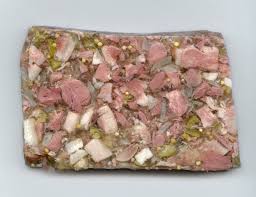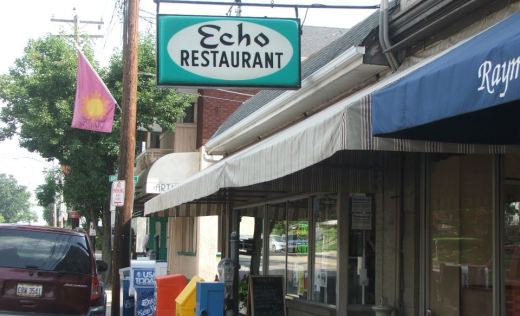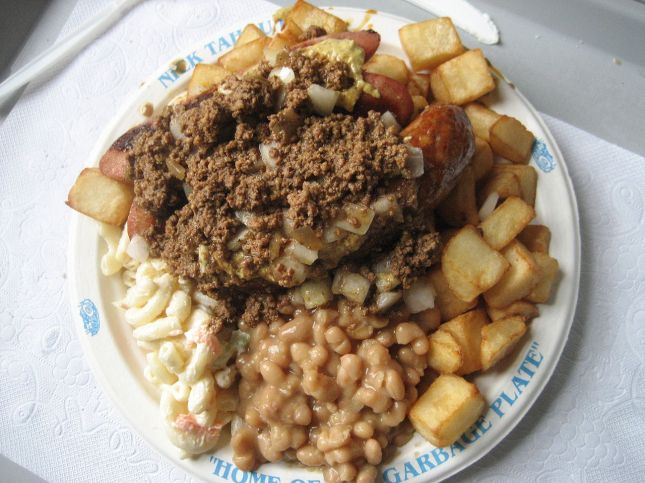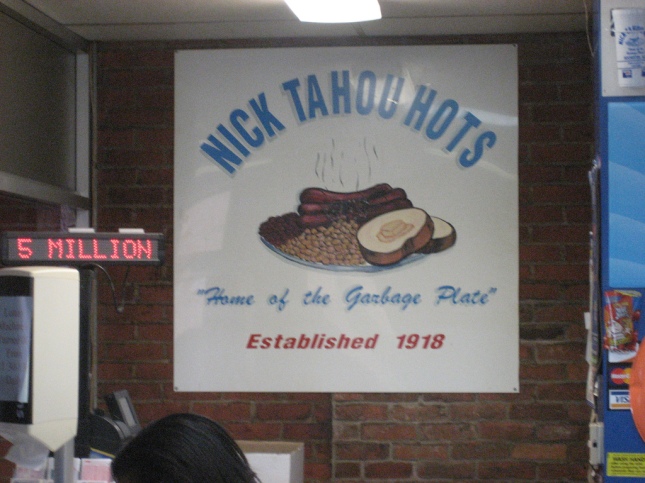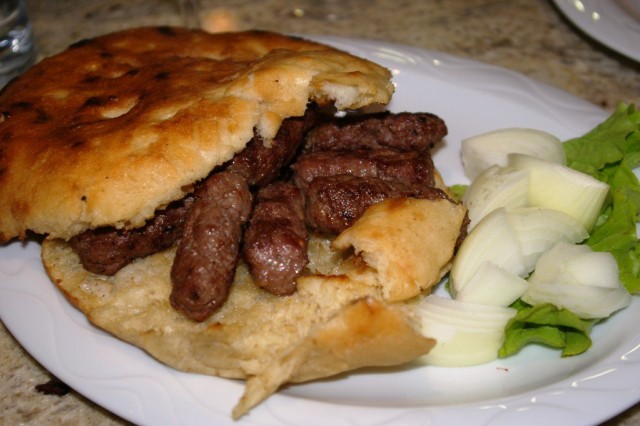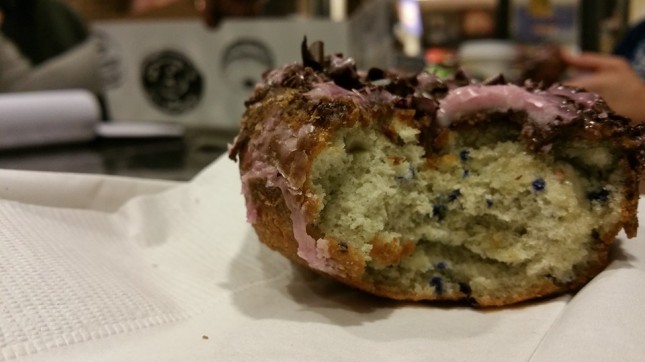
The Cincinnati Style Steak Hoagie.
Long before Subway and other sandwich chains were on every street corner and gas station, the independent pizza chains promoted subs or hoagie sandwiches. Of course the chili parlors had the market on the Greek double decker sandwich. As more independent pizza chains popped up there morphed two distinct types of Cincinnati Style Hoagies – the Cincinnati Steak Hoagie and the Baked Royal Hoagie.
The term hoagie is said to have originated in the Italian-American community of Philadelpha. Italian immigrant shipbuilders and dockworkers at Hog Island yard favored the sandwich during World War I. Working around the clock to produce ships for the war effort, they needed a portable convenience food. Many of their wives made them hearty loaf sandwiches stuffed with cheap lunchmeats, cheeses, and veggies, to hold them over. The “Hog Island” sandwich became known as a “Hog-ie,” which in Italian accented English sounds like “hoagie.”
The term travelled with Italian immigrants who moved west chasing manufacturing jobs in the early part of the 20th century. A good number of them settled in West Side Cincinnati, like Fairmount’s Little Italy neighborhood, and Newport, Kentucky’s Knob Hill or Spaghetti Knob neighborhood. The Church festival of San Antonio Catholic Church in Fairmount is credited for introducing this new ‘pizza pie’ to Cincinnati in the early 1950s, which was still exotic to the largely Germanic wurst-eating population. That parish nurtured the genesis of many of the early pizza parlors, including LaRosa’s and Pasquale’s.
Not to be confused with its distant cousin, the Philly Cheesesteak, which uses thinly sliced grilled steak and white American cheese, the classic Cincy steak hoagie is an oblong 8″ lightly seasoned ground steak patty, topped with melted mozzarella, or other shredded Italian cheese blend, pizza sauce or mushroom sauce, onion, and pickle on a split dense hoagie bun that can be sesame or poppy seed dusted.
The big difference across each pizza parlor is of course the difference in their sauce. You have anything from the super sweet San Marzano style sauce of LaRosa’s (the recipe coming from his maternal Grandmother Josephine Palmire Palarno’s family recipe from Salerno, Italy) to the oregano blast savory brown sauce of Pasquale’s pizza.
The hoagie is assembled open-faced with the two bun halves side-by-side (meat on the bottom bun) topped with sauce and cheese, then popped under the broiler or salamander until melted. Then pickles are added before the two halves are married, and the hoagie is cut in half. Onions should be baked on or sauteed separately, never raw. With the addition of sliced tomatoes and lettuce, it becames a Steak Hoagie Deluxe.
The first pizza parlor in Cincinnati, Capri Pizza, was established in 1949 by Daniel J. Vaccariello. Capri had its Gondola Sandwich, which is the grandfather of our Cincinnati Baked Royal Hoagie. The Gondola was an oversized footlong, on sweet sesame dusted soft Italian bread, hollowed out for a massive amount of meat and veggies. The similarity of this hollowed out bread to the shape of a Venetian gondoloa is how this sandwich got its name. It included Genoa salami, copocolla ham, provolone cheese, thinly sliced tomatoes, lettuce, roasted red peppers, sliced banana peppers, sliced black olives, thinly sliced red onions and dried oregano and Italian dressing. It would never include turkey, like Subway’s Italian BMT, as turkey is not an Italian meat. Daniel’s paternal grandfather, Michael, was from Metrica, Italy, but the Gondola was probably inspired by his mother, Antoinette Lariccia.
Now who decided to deface the Gondola and add pizza sauce is not known, but that formula – Italian sub plus pizza sauce – became the Cincinnati Style Baked Royal Hoagie. Of course, the bun also became more dense, as the Cincinnati style hoagie bun, and the easy-to-eat soft Italian bread was shunned.
The second pizza chain in Cincinnati, Pasquale’s came out with their Stromboli Steak Sandwich in 1958. They describe it as a juicy steak patty covered with mozzarella cheese, topped with mushroom gravy or pizza sauce, onions and pickles. The Stromboli is named after a group of islands in the Tyrrhenean Sea off the north coast of Sicily, known for its active volcano.
LaRosa’s have their Baked Royal hoagie, but they took it up a notch with the invention of their Baked Buddy Hoagie, named after the founder Buddy LaRosa, that is a Baked Royal with the addition of Pepperoni just to add to the heartburn.
Italianette Pizza, started in 1957 in Silverton, has a Cincinnati steak hoagie, but also has a Dagwood Hoagie, their version of the Baked Royal with salami, pepper loaf, pepperoni, pickles, pizza sauce, and cheese.
The term originated in the 1930s after a comic strip character named Dagwood Bumstead. According to the creator of the comic, Murat Bernard “Chic” Young (1901-1973), the only thing that Dagwood could prepare in the kitchen was a mountainous pile of dissimilar leftovers haphazardly arranged between two slices of bread. Dagwood became known for these huge sandwiches he created for midnight snacks. The Dagwood is a multilayered sandwich with an infinite variety of contents.
My mother used to make something called a Tuna Bumstead, which is also named after the 1930’s comic strip character. It’s broiled tuna salad with hardboiled egg on a coney bun. Most Cincinnati pizza joints also have a Tuna Hoagie in their repertoire.
Papa Dino’s Hot Royal hoagie was made from salami and capicola, rolled in paprika and red pepper, and served with banana pepper. After 58 years, Papa Dino’s closed their doors in 2012 in the highly competitive Clifton UC Campus pizza market.
The Hot Royal from Angilo’s has hard salami, ham, pepperoni, onions, lettuce, Italian dressing, cheese, pickles and pizza sauce. Angilo’s, started by in 1958, also has the Big John, their version of the steak sandwich with pizza sauce, mushroom sauce, or pickles and onions.
The Cincinnati Style Hoagie also expands outside of Hamilton County to Butler County legacy pizza joints. Richard’s Pizza in Hamilton, has a regionally famous steak hoagie, which they describe as seasoned lean beef, crunchy pickles, sweet Spanish onions and Richards original sauce on a hot buttered Italian or whole wheat bun. It can come with provolone or mozzarella, mushroom sauce, pizza sauce, grilled onions and peppers, jalapenos, or banana peppers.

